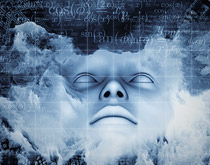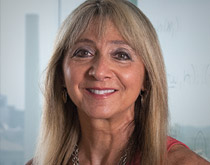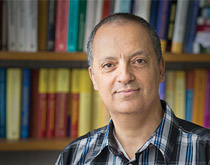 Shlomo Ta’asan looks at the data of a patient with cancer: vitals, DNA, cell counts, and thousands upon thousands of other biological factors. The massive amount of information is available because of today’s advanced biotechnology, which enables measurements of occurrences, such as the proliferation of specific immune cells in the body.
Shlomo Ta’asan looks at the data of a patient with cancer: vitals, DNA, cell counts, and thousands upon thousands of other biological factors. The massive amount of information is available because of today’s advanced biotechnology, which enables measurements of occurrences, such as the proliferation of specific immune cells in the body.
Although biologists and physicians now have greater insight into disease than ever before, the picture is certainly not complete. In order to develop targeted treatments and medicine for cancer and infectious diseases, researchers are challenged to piece together the complex interaction of the thousands of genes, cells, and other variables that make up one incredible biological puzzle—the human immune system.
This is no easy task. To Ta’asan, Carnegie Mellon Professor of Mathematics, the key to the puzzle lies in its numbers. More than a decade ago, he asked a question that many at the time were not asking: Is it possible to take all of the data from a patient with a viral infection, for instance, and use math to predict how the disease will progress and how the patient’s immune system will respond? Or more simply put, is it possible to mathematically “model” how the entire immune system behaves?
It sounds far-fetched, but complex questions like these with real-world applications intrigue mathematicians like Ta’asan and his colleagues at the Center for Nonlinear Analysis (CNA), a Carnegie Mellon research group and graduate/postdoctoral training center. There, researchers address a wide range of contemporary questions at the frontiers of engineering, bioengineering, materials science, and computer science. Here’s just a sampling.
• How do materials used in electronics, such as silicon and germanium, develop structural imperfections (called quantum dots) during their fabrication (which is key to developing more robust computers and handheld devices)?
• How can we more efficiently tell the differences between healthy cells and malignant cells (which would lead to breakthroughs in treating various types of cancer)?
• What are the inherent properties of “smart materials” (which are designed materials that can change their properties in response to their environment)? Case in point: Predicting how the atomic structure of shape-memory alloy metals reacts to changes in heat, pressure, magnetism, and other forces has far-reaching implications—ranging from the development of aircraft to robotics to life-saving biomedical devices such as cardiovascular stents.
While spanning many different fields, these problems have a common theme; all involve inherent complexities that can be best deciphered by mathematicians, says Irene Fonseca, University Professor of Mathematics and CNA’s director.
 Fonseca works extensively with imaging, using math to perform tasks such as un-blur images and remove or add color. Her work is important to the field of computer vision research, in other words, helping machines and artificial systems to “see.”
Fonseca works extensively with imaging, using math to perform tasks such as un-blur images and remove or add color. Her work is important to the field of computer vision research, in other words, helping machines and artificial systems to “see.”
To the casual observer, the mathematical model Fonseca works with is an indecipherable string of mathematical language—symbols, exponents, Greek letters. To Fonseca, though, it’s the key to taking the numerical information from her image data to predict outcomes.
The same is true for Ta’asan. In one aspect of his research, he’s collaborating with immunologists in Florida and Brazil who study Dengue fever, a mosquito-borne viral disease with no vaccine that infects millions of people worldwide every year. Through a mathematical equation, using data from infected patients, he’s working on predicting whether a patient will become severely ill; many times, his findings are counterintuitive to what biology alone would predict, dictating a different treatment protocol.
CNA is working to “close the loop” between math and engineering—applicable to imaging, energy, health sciences, and new technologies, says Fonseca, as it becomes more apparent that mathematical models and other mathematical tools can describe and predict complex behaviors.
 Funded consistently for more than 20 years by competitive multi-million-dollar grants from the National Science Foundation (NSF), mathematicians at CNA (nine permanent faculty members) collaborate closely with faculty from the Mellon College of Science and the College of Engineering within Carnegie Mellon, as well as the University of Pittsburgh Medical Center.
Funded consistently for more than 20 years by competitive multi-million-dollar grants from the National Science Foundation (NSF), mathematicians at CNA (nine permanent faculty members) collaborate closely with faculty from the Mellon College of Science and the College of Engineering within Carnegie Mellon, as well as the University of Pittsburgh Medical Center.
But CNA’s scope reaches far beyond Pittsburgh. Fonseca—President of the Society for Industrial and Applied Mathematics, an international community of more than 14,000 individual members—has forged numerous partnerships with math and science institutions throughout the world since becoming CNA’s director in 1998.
For instance, she leads a special global project funded by the NSF called PIRE—Partnerships for International Research and Education—which facilitates research and educational opportunities in applied analysis and materials science. Among the 10 participating institutions are Carnegie Mellon, Caltech, New York University, the University of Minnesota, and seven European partners that include leading research institutions and an industrial partner.
In addition to PIRE, CNA functions as a U.S. node to a European network that offers CNA’s postdocs and investigators joint research opportunities with leading European universities.
To Fonseca, one of CNA’s greatest contributions is its pipeline of graduate students and postdocs who are driving the research of tomorrow. Many of the near 80 postdoctoral students who have trained at the center since its inception are now leading scientists, principal investigators, and directors of top mathematics and science research centers and institutes throughout the world.
Of note are two former postdocs who are leaders of PIRE partners:
Felix Otto is one of the directors of the Max Planck Institute for Mathematics in the Sciences in Leipzig, Germany, which ranks among the world’s top mathematics and applied research centers.
Stefan Müller is Associate Director of the Hausdorff Research Institute for Mathematics, at the University of Bonn, which is one of Germany’s leading academic institutions.
CNA’s “footprint” will continue to grow worldwide, says Fonseca, because research projects like the Brain Mapping Initiative and the Materials Genome Project require experts in rigorous mathematical analysis.
For Ta’asan, it’s all leading to the day when a “math box” will be used in every medical examination so physicians can predict health outcomes of their patients through the mathematical interpretation of data.



